MP Board Class 7th Science Solutions Chapter 9 Soil
Soil Intext Questions
Question 1.
I wonder why I found some pieces of plastic articles and polythene bags in the soil sample collected from the roadside and the garden?
Answer:
It is because people throw used plastic things and polythene bags in the soil.
Question 2.
I want to know whether ‘the soil from a field can be used to make toys?
Answer:
Yes.
Question 3.
I want to know: What kind of soil should be used for making making and surahis?
Answer:
Clayey soil.
![]()
Question 4.
Boojho wondered why there was a difference in the absorption of water in the two squares?
Answer:
Because different soils are used to make the two squares.
Question 5.
What is the difference between rate of percolation and the amount of water retained?
Answer:
Rate of percolation is the amount of water percolated per unit time through soil. Whereas the amount of water retained is the amount of water absorbed by soil. Thus, rate of percolation and water retention are opposite attributes.
Activities
Activity 1
Collect some soil samples and observe them carefully. You can use a hand lens. Examine each sample carefully and fill in Table. Answer:
Table
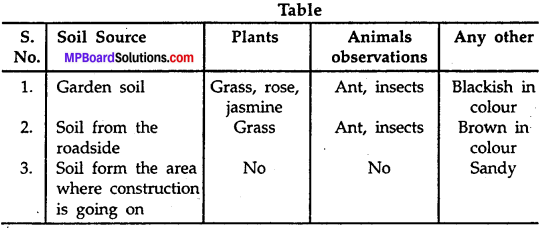
Activity 2
Take a little soil. Break the clumps with your hand to powder it. Now take a glass tumbler, three quarters filled with water, and then add a handful of soil to it. Stir it well with a stick to dissolve the soil. Now let it stand undisturbed for some time. Afterwards, observe it and answer the following questions:
- Do you see layers of particles of different sizes in the glass tumbler?
- Draw a diagram showing these layers?
- Are there some dead rotting leaves or animal remains floating on water?
Answer:
- Yes
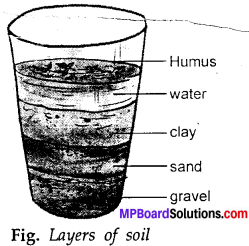
- Yes
![]()
Activity 3
Find from your teachers, parents and farmers the type of soils and crops grown in your area. Enter the data in the following Table,
- Which kind of soil would be most suitable for planting rice?
- Soil with a higher or lower rate of percolation?

Answer:

- Loamy soil.
- Lower rate of percolation.
Soil Text Book Exercises
Tick the most suitable answer in questions 1 and 2.
Question 1.
In addition to the rock particles, the soil contains?
- Air and water
- Water and plants
- Minerals, organic matter, air and water
- Water, air and plants.
Answer:
3. Minerals, organic matter, air and water.
Question 2.
The water holding capacity is the highest in?
- Sandy soil
- Clayey soil
- Loamy soil
- Mixute of sand and loam.
Answer:
2. Clayey soil.
Question 3.
Match the items in Column I with Column II:
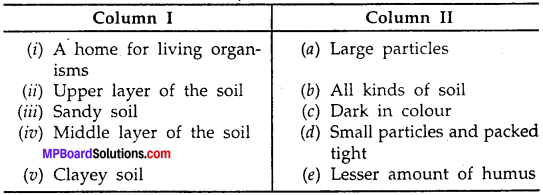
Answer:
(i) (b)
(ii) (c)
(iii) (a)
(iv) (e)
(v) (d).
Question 4.
Explain how soil is formed?
Answer:
The soil is the mtter which cover the top most layer of the earth in most of area. It is one of the most important natural resources. Long ago earth was a very hot sphere and then converted into a very hard and rocky land. These rocks were broken into smaller pieces by violent earthquakes. Volcanic eruptions also made the rocks and lava into smaller pieces. In cold temperatures the ice in the services of rocks expanded to break it into smaller pieces and thus gradually the soil was formed. The nature of any soil depends upon the rocks from which it has been formed and the type of vegetation that grows in it.
![]()
Question 5.
How is clayey soil useful for crops?
Answer:
Clayey soil is good at retaining water. They, are rich in humus and are very fertile. They also hold sufficient water due to the presence of smaller particles and certain enough air due to the presence of some large particles.
Question 6.
List the differences between clayey soil and sandy soil?
Clayey soil:
- They contains more than 50% of clay particles.
- Water holding capacity is very high.
- Suitable for plant growth.
- Low percolation rate.
Sandy Soil:
- They contains about 60% of sand particles.
- Water holding capacity is very low.
- Not suitable for plant growth.
- High percolation rate.
Question 7.
Sketch the cross section of soil and label the various layers?
Answer:
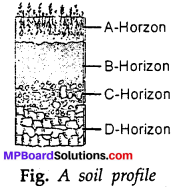
Question 8.
Razia conducted an experiment in the field related to the rate of percolation. She observed that it took 40 min for 200 mL of water to percolate through the soil sample. Calculate the rate of percolation.
Answer:
We know that,
![]()
Thus, the rate of percolation is 5ml/min.
Question 9.
Explain how soil pollution and soil erosion could be prevented?
Answer:
Polythene bags and plastics pollute the soil. They also kill the organisms living in the soil. That is why there is a demand to ban the polythene bags and plastics. Other substances which pollute the soil are a number of waste product, chemicals and pesticides. Waste products and chemicals should be treated before they are released into the soil.
The use of pesticides should be minimised. Soil erosion can be slowed down and soil can be conserved by regulating the factors responsible for it. Some methods to prevent or slow down the soil erosion are:
- To stop the unnecessary cutting of forests and trees.
- To stop the excessive use of grass land due to overgrazing by cattle.
- Growing vegetation along the boundary of the fields and open grounds.
- Making use of proper and scientific methods for cultivation such as crops rotation. This maintains the natural fertility of the soil and at the same time soil also maintains its capacity to hold water. Soil remains wet and cannot be easily carried away by water and blown up by wind.
- Making use of scientific methods for irrigation and water drainage.
- Gutting the hill slopes into steps or terraces and adopting terrace cultivation on hill slopes.
![]()
Question 10.
Solve the following crossword puzzle with the clues given:
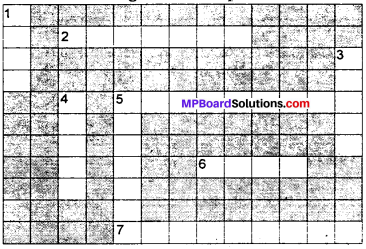
Across:
2. Plantation prevents it.
5. Use should be banned to avoid soil pollution.
6. Type of soil used for making pottery.
7. Living organism in the soil.
Down:
1. In desert soil erosion occurs through.
3. Clay and loam are suitable for cereals like.
4. This type of soil can hold very little water.
5. Collective name for layers of soil.
Answer:
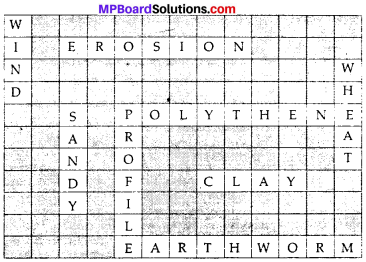
Soil Additional Important Questions
Soil Objective Type Questions
Question 1.
Choose the correct alternative:
Question (i)
The constituents of the soil are –
(a) Mineral particles, air and water
(b) Living of organisms
(c) Organic and inorganic substances
(d) All of these.
Answer:
(d) All of these.
Question (ii)
Soil is the thin layer of fine material containing –
(a) Organic matter
(b) Air and water
(c) Weathered rock materials
(d) All of these.
Answer:
(d) All of these.
Question (iii)
Soil formation is brought about by –
(a) physical factors
(b) Chemical factors
(c) Biological agent
(d) All of these.
Answer:
(d) All of these.
Question (iv)
Which profile contains humus –
(a) A – horizon
(b) B – horizon
(c) C – horizon
(d) R – horizon.
Answer:
(a) A – horizon
![]()
Question (v)
Which of these has the smallest size of particles –
(a) Sand
(b) Silt
(c) Clay
(d) Gravel.
Answer:
(b) Silt
Question (vi)
What kind of soil is best for growing cotton –
(a) Black soil
(b) Alluvial soil
(c) Red laterite soil
(d) Mountain soil.
Answer:
(a) Black soil
Question (vii)
What kind of soil is good for growing tea and coffee –
(a) Red laterite soil
(b) Black soil
(c) Laterite soil
(d) Mountain soil.
Answer:
(c) Laterite soil
Question (viii)
The dead and decaying organisms are –
(a) Humus
(b) Gravel
(c) Clay
(d) Inorganic material.
Answer:
(a) Humus
Question (ix)
Which kind of soil is best for growing wheat, rice and sugarcane –
(a) Black soil
(b) Mountain soil
(c) Alluvial soil
(d) Desert soil
Answer:
(c) Alluvial soil
Question 2.
Fill in the blanks:
- Wheat and rice grow best in …………… soil.
- Humus is present in the ………….. layer of soil, known as the ………….. horizon.
- Clay is the smallest size of particles less than …………… in diameter.
- …………… is a mixture of sand, silt, clay and humus.
- Weathering of rocks is a …………… process.
- …………… is the breaking down of rocks into smaller pieces.
- Soil commonly found in India is of …………….. main types.
- Red colour of the soil is due to ………………
Answer:
- Alluvial
- Upper, A
- 0.002 mm
- Loam
- Slow
- Weathering
- Six
- Iron.
![]()
Question 3.
Which of the following statements are true (T) or false (F):
- The soil is uppermost layer of the land surface.
- The soil with particle size greater than 2 mm in diameter is gravel.
- The soil with particle size greater than 2 mm in diameter is clay.
- Decayed organic matter in the soil forms humus.
- Most fertile farm lands consist of alkaline soil.
- No humus is present in C – horizon.
- Black soil is rich in iron and magnesium.
- B – horizon is the most fertile part of the soil.
- Laterite soil is rich in nutrients.
- Soil is classified in sand, silt and clay.
- The process of .carrying away of top soil by natural process is called soil erosion.
- Black soil is loamy in texture with plenty of humus.
- Overgrasing is a means of soil conservation.
- Extremely acidic soil supports plants.
- Planting of trees in a large area is known as afforestation.
Answer:
- True (T)
- True (T)
- False (F)
- True (T)
- False (F)
- True (T)
- True (T)
- False (F)
- True (T)
- True (T)
- True (T)
- False (F)
- False (F)
- False (F)
- True (T).
Match the items in Column A with items in Column B:
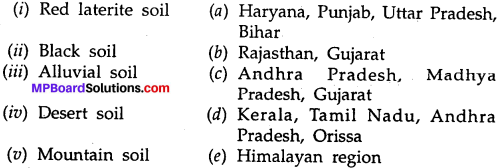
Answer:
(i) (d)
(ii) (c)
(iii) (a)
(iv) (b)
(v) (e).
Soil Very Short Answer Type Questions
Question 1.
Mention two main components of soil?
Answer:
The two main components of soil are mineral particles and organic particles.
Question 2.
Name the different types of particles present in the soil?
Answer:
The different types of particles present in the soil are water, air, humus, mineral particles and living organisms.
Question 3.
What is soil?
Answer:
The soil is the outer layer of earth’s crust capable of supporting plant growth.
Question 4.
Mention two functions of soil?
Answer:
The two functions of soil are:
- It provides water and minerals to the plants.
- It provides anchorage to the plants.
![]()
Question 5.
What is the role of plants in the formation of soil?
Answer:
The roots of plants on penetrating into the crevices of rocks break these and help in the formation of soil.
Question 6.
Name some of the living organisms which are present in the soil?
Answer:
Fungi, bacteria, earth worms, round worms, and protozoams are the living organisms present in the soil.
Question 7.
What do you mean by soil texture?
Answer:
The structure or texture of soil determines the relative proportion of particles of different sizes.
Question 8.
What is the difference between soil texture and structure?
Answer:
Soil texture pertains to particle size, composition of a soil and soil structure refers to arrangement of soil particles into aggregates.
Question 9.
What is meant by the term weathering?
Answer:
Weathering is the breaking down of huge pieces of rocks into smaller pieces by the action of natural forces, such as water, wind, glaciers and roots of plants.
Question 10.
Which layer of soil contains the largest rock pieces?
Answer:
Bedrock contains the. largest rock pieces.
Question 11.
Which layer of soil will have the highest humus content and which the least?
Answer:
The upper most layer (A-horizon) will have the highest humus content and lowest layer (C-horizon) will have the least.
Question 12.
Which types of soil is most suitable for crops like wheat, rice and sugarcane?
Answer:
Alluvial soils is the most suitable for crops like wheat, rice x – and sugarcane.
Question 13.
Define residual soil?
Answer:
The soil which remains at the place of its formation is called residual soil.
Question 14.
Which soil is classified as alluvial type?
Answer:
The soil transported by flowing water is classified as alluvial type.
Question 15.
What are mountainous soil?
Answer:
Mountainous soil consist of clay, shales, sandstones and limestones. This type of soil is usually found in depressions and valley basins or on gently inclined slopes.
Question 16.
Define loam?
Answer:
Loam is a mixture of sand, silt and clay and also has humus in it.
![]()
Question 17.
What is soil pollution?
Answer:
The contamination of soil with excess of fertilizers, herbicides, weedicides, insecticides and industrial waste is called soil pollution.
Question 18.
Define soil moisture?
Answer:
Soil holds water in it, which is called soil moisture.
Question 19.
Name the three types of soil erosion?
Answer:
The three types of soil erosion are sheet erosion, gaily erosion and wind erosion.
Question 20.
How does vegetation help to prevent soil erosion?
Answer:
Flowing water and wind take away the top layer of the soil if there is no vegetation. The grasses, trees hold the soil in place.
Question 21.
How does soil erosion take place?
Answer:
Soil erosion can take place by natural processes such as floods, forest fire, winds, deforestation and overgrazing.
Question 22.
Which horizon of soil profile contains humus?
Answer:
A – horizon of soil profile contains humus.
Question 23.
Which type of soil is classified as residual soil?
Answer:
The soil, which remains at the place of its formation is called residual soil. This type of soil is generally poor in nitrogen, phosphorus and humus.
Question 24.
The soil at a given place was found to consist of sand stones, clay, shales and limestone. What is the type of the soil and how it might have formed?
Answer:
The type of the soil is mountainous soil. It might have formed, when the weathered soil particles are taken away to other places.
Soil Short Answer Type Questions
Question 1.
What does soil consist of?
Answer:
Soil consists of tiny bits of mineral particles which come from larger rocks and humus which is dark brown in colour and consists of decaying remains of plants and animals. Soil also contains water, air and living organisms such as bacteria, fungi, earth worms, round worms, and insects etc.
Question 2.
How is the soil formed? Explain in brief?
Answer:
Millions years ago, the surface of earth was very hard, rugged and rocky. In the long run, weathering of these rocks resulted in formation of soil which with the flow of river water came down to the lower plains and got deposited. Gradually it spread out on whole surface of the earth. Formation of soil is a very slow process. In this process rocks crack and break down into fine particles to form soil.
Question 3.
Define alluvial soil and its distribution?
Answer:
Alluvial soil is loamy soil which contains abundant amount of water in it. This is very fertile soil. This type of soil is very suitable for the production of wheat and rice. This soil is found in the plains of northern India, i.e., in the state of Punjab, Bihar, Haryana, Uttar Pradesh and West Bengal.
![]()
Question 4.
What are physical properties of soil?
Answer:
The physical properties of soil are:
- Colour
- Moisture storage capacity
- Texture
- Presence of living organisms
- Porosity.
Question 5.
Give an account of the importance of physical properties of soil?
Answer:
The physical properties .of soil exert a great influecne on soil fertility. These are taken into consideration when soil is to be used as a medium for plant growth but also when soils are to be [ used as a structural material for making highways, dams, foundation for buildings as well as for the manufacture of bricks and tiles.
Question 6.
What are organic and inorganic components of soil?
Answer:
The inorganic components of soil comprise minerals which are derived from fragmentation and weathering of rocks. The porespaces formed between the mineral particles of soil are filled with water and gases. The organic component of soil comprise organic wastes, dead animals, plants and their decomposition products.
Question 7.
Explain the role of various organisms present in the soil?
Answer:
Bacteria in the soil helps in decomposing dead remains of plants and animals to make humus. Some bacteria can convert atmospheric nitrogen into water soluble nitrates which plants can easily use for their growth. Earthworms help in loosening of soil. They also improve the texture of the soil thus causing better growth of plants.
Question 8.
Name four common sources of pollution of soil?
Answer:
The common sources of pollution of soil are:
- Excessive use of fertilisers.
- Spraying of crops with insecticides and herbicides.
- Garbage and other kitchen refuge.
- Industrial wastes such as chemicals, plastic, leather, fly ash, etc.
Question 9.
Define A – horizon layer. Give also the main characteristic of A – horizon.
Answer:
A – horizon layer:
The uppermost layer of the soil is called A – horizon. It is generally known as upper soil or earth’s crust. The main characteristics of this layer of soil are as under:
- It generally bears dark colour.
- It contains lot of dead and decaying plant and animal matter called humus.
- Due to presence of humus this layer is highly fertile.
- The soil in this layer is porous, soft and has comparatively more water retaining capacity.
- In this layer living organisms such as earth worms, insects, bacteria and fungi etc. are found.
![]()
Question 10.
Define B – horizon layer. Also give the main characteristics of B – horizon.
Answer:
B – horizon layer:
This layer lies next to A – horizon. The main characteristics of this layer of soil are as under:
- The colour of this layer is comparatively dull.
- This layer of soil is usually harder and more compact than the top soil.
- This layer contains very less amount of organic matter in it.
- This layer is rich in iron oxide and soluble mineral salts,
- Roots of large and old trees are found in this layer.
Question 11.
Differentiate between Alluvial soils and Desert soils.
Answer:
Alluvial soils:
- Loamy in texture with plenty of humus.
- Very fertile, good for crops like wheat and rice.
- In India, it is mainly found in the plains of Uttar Pradesh, Haryana, Bihar, West Bengal and in the coastal regions of Orissa and Andhra Pradesh.
Desert soils:
- Soil sandy and porous, cannot hold much water.
- If irrigated, crops can be grown.
- In India, it is mainly found in Rajasthan and in some parts of Gujarat.
Soil Long Answer Type Questions
Question 1.
Describe the various steps involved in the formation of soil?
Answer:
There is a hard surface of the rocks just below the layer of the soil. In the past, these rocks were broken into smaller pieces by a process known as weathering. Weathering is the breaking down of huge pieces of rocks into smaller pieces by the action of natural forces, such as water, wind, glaciers and roots of plants, etc.
1. Rain water enters crevices of rocks. In winter, as this water freezes, it expands. This expansion breaks the rocks into smaller pieces.
2. The broken pieces roll down by the force of flowing or wind.
3. The broken pieces get converted into very fine particles, and mix with humus to form soil.
4. Roots of tree growing through rocks exert great pressure on the rocks. This causes cracks in the rocks, leading to weathering.
5. Large variation in day and night temperatures.
6. In hot and humid climates, the minerals in rocks react with oxygen of the air. Such oxidised rocks crumble to form soil.
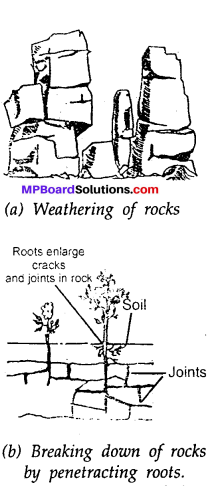
Question 2.
Describe various types of soil on the basis of their classification?
Answer:
There are mainly six types of soil found in India. These are:
1. Red soil:
It is red in colour due to the presence of red iron oxide in it. It is poor in humus but can be made fertile by adding manure. This type of soil is generally found in southern part of. India.
2. Black soil:
It is derived from the lava of volcanic eruptions and is rich in minerals containing iron and magnesium. This type of soil is found in Maharashtra and parts of Madhya Pradesh, Gujarat and Andhra Pradesh.
3. Alluvial soil:
It is a loamy soil which contains abundant amount of water in it. This is very fertile soil. This type of soil is very suitable for the production of rice and wheat. This soil is found in the plains of northern India.
4. Desert soil:
It is grey to brown in colour. The soil is sandy and porous, and cannot hold much water. This soil is found in Rajasthan and Gujarat.
5. Mountain soil:
It has the highest humus content among all soils in India. These soils are highly, fertile. This soil is found in the Himalyan region and the north – eastern parts of India.
6. Laterite soil:
It is red in colour and good for crops such as tea, coffee and coconut. This type of soil is typical of the rainy climate and rich in nutritive elements. This soil is found in Tamil Nadu, Andhra Pradesh, Assam and Orissa.
![]()
Question 3.
Write an essay on the importance of soil?
Answer:
Soil is an important part of our earth. It is not only a natural habitat for various worms and insects but plants also grow and absorb water and minerals for their growth and development in the soil.
1. For food, clothing and shelter:
By supporting growth of plants, the soil provides us with food. Much of our clothing, such as cotton and wool, can be traced to the soil. Plants also provide us fuel, paper, medicines and wood for use in furniture and for constructing houses.
2. For minerals:
We depend on the soil for minerals. Industries use the minerals dug out from the earth to extract metals such as gold, silver, iron, etc. and for use in thousands of industries that produce various useful things for us. Minerals, such as petroleum, natural gas, and coal obtained from soil provide us fuel and many other useful things.
3. For clay:
We depend on the soil for clay which is the raw material used to make tiles, bricks, procelain and pottery.
4. For water:
We depend on the soil for water. Water that seeps into the soil is stored underground as subsoil water. We use this water for drinking and other purposes.
Question 4.
Write a note on soil erosion?
Answer:
The process of water or wind carrying away soil from one place to another is called soil erosion. Following are the main reasons for soil erosion:
1. Erosion by natural forces:
Fast moving wind generally . carries away with it the top soil from the surface of the earth. Similarly, heavy rainfall creates flood situation and fast moving water washes away with it the top fertile soils from our fields which combinely result into erosion of soil.
2. Erosion by human activities. Various human activities are responsible for erosion of soil such as cutting of forests, improper and unscientific methods of agriculture and extensive use of grass lands.
![]()
Question 5.
What are the main causes for the erosion of soil?
Answer:
The main causes for the erosion of soil are:
1. Cultivation:
Continuous cultivation of land by only one type of crop further adds to the loss of soil fertility. Once the top of soil is lost, the sub-soil becomes a part of the layer for cultivation. This layer has less nutrient retention power, organic matter and aeration.
2. Deforestation:
It is due to increasing population and increasing industrialization. Deforestation leads to flooding and soil erosion. Forested land looses one tonne of soil per year whereas unforested land looses approximately 40 times more soil.
3. Floods:
The soil taken away by flood often gets deposited in ponds, rivers and lakes’. This causes the water to become muddy and reduces the depth of ponds, rivers and lakes. It also raises their bed due to silting, which has an adverse impact on aquatic life.
4.Overgrasing:
Animal overgrase the slopes that leads to removal of vegetation cover from the soil. All these animals pulverise the soil which is easily washed away in time of heavy rainfall. By overgrasing the soil is denuded of its protective covering of roots and grass.
Question 6.
How will you demonstrate that the vegetation prevents erosion of soil?
Answer:
Take two trays or baskets. Fill them with garden soil. Grow grass or some cereal in one of them and water it properly for a few days. Now keep both the trays in a slightly inclined position by placing a brick below their one side. Let the water fall on both the trays. You will find that the water that flows from the tray with vegetation contains less amount of soil particles in it. This is due to the fact that the roots of plants bind the soil and do not allow it to flow with water.
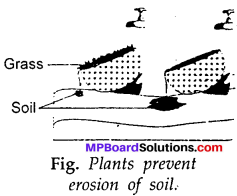
Question 7.
Differentiate between Black soils and Red soils?
Answer:
Black soils:
- Rich in iron and magnesium derived from basaltic rocks.
- Soil is clayey, contains dead organic matter and water; ideal for growing cotton and sugarcane.
- In India, it is mainly found in Maharashtra, parts of Andhra Padesh, Madhya Pradesh and Gujarat.
Red soils:
- Red colour is due to the presence of iron oxide.
- Poor in humas but cannot be made fertile by adding manure or fertilizers.
- In India, it is found in interior regions of Kerala and Tamil Nadu, Southern Karnataka, Andhra Pradesh, Orissa, Eastern Madhya.
![]()
Question 8.
What are the human activities responsible for soil erosion?
Answer:
The various human activities responsible for soil erosion are:
1. Cutting of forests:
With the increase in population and civilisation, deforestation started. Deforestation disturbed the natural habitat of wild animals and at the same time, it enchanced the process of soil erosion.
2. Improper and unscientific methods of agriculture:
Improper and unscientific methods of agriculture also increase the rate of soil erosion.
3. Extensive use of grass lands:
Extensive use of grass lands due to overgrazing by cattle also reduces grass and other, vegetation on the earth which causes erosion of soil.